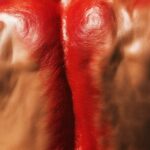Infrared radiation is a form of electromagnetic radiation that is invisible to the human eye but is still capable of causing harm to human skin. While we may not be able to see it, infrared radiation can have negative effects on our skin, from sunburns to long-term damage. In this article, we will discuss why infrared waves are harmful to human skin and how to protect ourselves from potential harm.
Infrared waves are harmful to human skin because they can cause burns, similar to those caused by the sun. Long-term exposure to these waves can lead to premature aging, wrinkles, and other skin problems. To protect yourself from the harmful effects of infrared waves, use protective clothing, sunscreen, and avoid prolonged exposure.

Contents
What are Infrared Waves?
Infrared (IR) waves refer to a type of electromagnetic radiation emitted by the sun and other hot sources. It is typically invisible to the human eye but can be felt as heat. Infrared waves have a longer wavelength than visible light, making them useful in a variety of applications, including medical imaging and night vision.
Infrared waves are divided into three regions: near-infrared, mid-infrared, and far-infrared. Near-infrared has the shortest wavelength and is closest to visible light, while far-infrared has the longest wavelength and is the least energetic.
Effects of Near-infrared on Human Skin
Near-infrared radiation has the highest energy and is the most hazardous to human skin. Prolonged exposure to near-infrared radiation can cause thermal damage to the skin and lead to premature aging, discoloration, and an increased risk of skin cancer.
In addition, near-infrared radiation is thought to decrease the body’s ability to repair damaged DNA. This can lead to mutations in cells and increase the risk of skin cancer over time.
Effects of Mid-infrared on Human Skin
Mid-infrared radiation has less energy than near-infrared radiation, but it can still cause thermal damage to the skin. Prolonged exposure to mid-infrared radiation can lead to premature aging, discoloration, and an increased risk of skin cancer.
Mid-infrared radiation is also thought to interfere with the body’s natural healing process, which can increase the risk of skin cancer over time.
Effects of Far-infrared on Human Skin
Far-infrared radiation has the least energy and is the least hazardous to human skin. While prolonged exposure to far-infrared radiation can still cause thermal damage to the skin, the risk is much lower than with near- or mid-infrared radiation.
How to Reduce Risk of Infrared Radiation Damage
The best way to reduce the risk of infrared radiation damage is to limit exposure. Wearing protective clothing, such as long-sleeved shirts and pants, can help block some of the radiation.
In addition, using sunscreen with broad-spectrum protection can help protect the skin from ultraviolet and infrared radiation. Sunscreens with an SPF of 30 or higher are recommended for optimal protection.
Conclusion
Infrared radiation can be hazardous to human skin, especially near- and mid-infrared radiation. Prolonged exposure can lead to thermal damage, premature aging, discoloration, and an increased risk of skin cancer. To reduce the risk of infrared radiation damage, it is important to limit exposure and use sunscreen with broad-spectrum protection.
Frequently Asked Questions
What is Infrared Radiation?
Infrared radiation is a type of electromagnetic radiation, with a wavelength that is longer than visible light but shorter than microwaves. It is invisible to the human eye, but can be detected by certain sensors. It is used in many everyday applications, such as in television remote controls and night vision goggles.
How is Infrared Radiation Generated?
Infrared radiation is generated when an object’s temperature is higher than absolute zero. The higher the temperature of the object, the more infrared radiation is generated. This means that infrared radiation is present in all objects, including the human body, and is also generated by the sun.
What is the Effect of Infrared Radiation on Human Skin?
Exposure to infrared radiation can be harmful to the skin, as it can cause the skin to be burned or damaged. Prolonged exposure can lead to the development of sunburns, premature aging, and even skin cancer.
How Can Infrared Radiation be Reduced?
The most effective way to reduce exposure to infrared radiation is to use sunscreen and protective clothing when spending time outdoors. Wearing sunglasses and hats can also help to reduce exposure, as can limiting the amount of time spent in direct sunlight.
What are the Long-Term Effects of Infrared Radiation?
The long-term effects of infrared radiation depend on the amount of exposure. Prolonged exposure can cause skin pigmentation changes, premature aging, and even skin cancer. It is important to limit exposure to infrared radiation to reduce the risk of developing any of these conditions.
What are Examples of Devices that Use Infrared Radiation?
Devices that use infrared radiation include television remote controls, night vision goggles, and some medical imaging devices. Infrared radiation is also used in some heating systems, such as infrared saunas. Finally, infrared radiation is also used in some security systems, as it can be used to detect motion.
The Secret Reason Infrared Heat Can Heal Neck, Back, Shoulder, Hip Pain & More!
Infrared waves are an invisible light spectrum that has multiple uses, but it can also be harmful to human skin. Extended exposure to infrared radiation can cause burns and long-term damage to the skin. Therefore, it is important to be aware of the potential risks associated with infrared radiation and to take precautions when using devices that emit infrared waves. By wearing protective clothing and avoiding prolonged exposure to infrared waves, individuals can ensure they are not putting their skin at risk.








